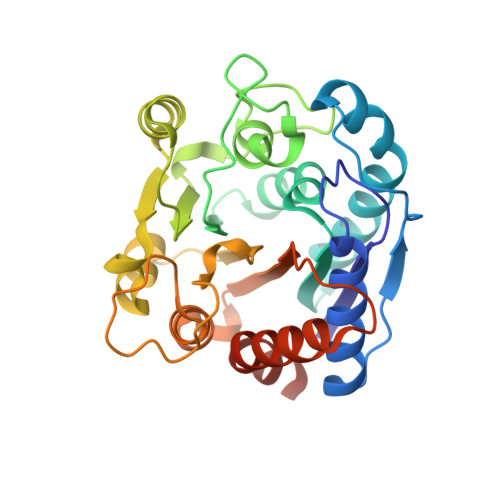Copper inactivates DcsB by oxidizing the metal ligand Cys86 to sulfinic acid.
Oda, K., Komaguchi, K., Matoba, Y.(2024) FEBS J 291: 5486-5505
- PubMed: 39563074
- DOI: https://doi.org/10.1111/febs.17325
- Primary Citation of Related Structures:
9IXC, 9IXD, 9IXE, 9IXF, 9IXG - PubMed Abstract:
N ω -hydroxy-l-arginine amidinohydrolase (EC:3.5.3.25), an enzyme in the d-cycloserine (d-CS) biosynthetic pathway of Streptomyces lavendulae, catalyzes the hydrolysis of an arginase inhibitor, N ω -hydroxy-l-arginine, to produce l-ornithine and hydroxyurea, despite being homologous to arginase. Like arginase, the enzyme (DcsB) possesses two manganese ions (Mn A and Mn B ) essential for the enzymatic reaction at the bottom of the cavity formed within the molecule. However, one of the Mn A ligands in DcsB is Cys86, whereas the corresponding residues in arginase are histidine. In this study, we determined the crystal structure of Mn-free DcsB to elucidate the installation mechanism of the manganese ions. The flipping of the His111 residue after the formation of the coordination bond to the second manganese ion may facilitate the installation of Mn B and the closing of the cavity entrance to retain Mn A and Mn B at the active site. Copper ions, which are known to be a positive regulator of many secondary metabolites in Streptomyces species, were found to irreversibly inactivate the catalytic activity of DcsB. Mass spectrometric and crystallographic analyses of the Cu(II)-treated DcsB indicated that Cys86 is oxidized to sulfinic acid. The d-CS biosynthesis in the producing microorganism may be negatively regulated by the concentration of intracellular copper ions, which mediates the oxidative stress.
- Department of Virology, Institute of Biomedical and Health Sciences, Hiroshima University, Japan.
Organizational Affiliation:



















